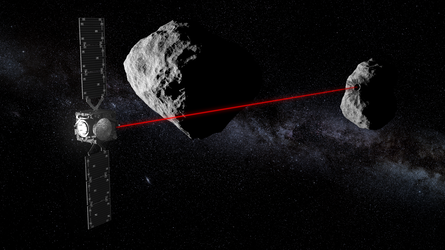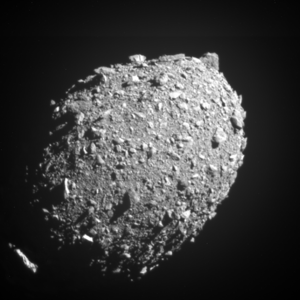Hera operations
ESA’s Hera mission launched on 7 October 2024 and is controlled from the European Space Operations Centre (ESOC), ESA’s mission control centre in Darmstadt, Germany.
The mission operations team
The Hera operations team defined the spacecraft’s trajectory and orbit at Didymos and built and tested its ground segment. Throughout 2024, they have been conducting a series of System Validation Tests that connect the newly installed mission control systems at ESOC with the satellite as it undergoes integration and final testing at ESA’s ESTEC technical centre in the Netherlands. This enables the team to test and validate all interfaces with the actual spacecraft.
Hera will be operated by a Flight Control Team (FCT) from a Dedicated Control Room at ESOC. The FCT will be supported by specialist teams at ESOC from functional areas such as flight dynamics, ground facilities and tracking stations and mission data systems, particularly during the satellite’s crucial ‘Launch and Early Orbit Phase’.
Prior to launch, Hera’s these teams will undergo an intensive simulations campaign as they are trained together into a single, integrated Mission Control Team focussing on time-critical and possible contingency operations on and around launch day.
Hera’s journey

Once launched, Hera will begin a two-year cruise phase. An initial deep space manoeuvre in late October 2024 will be followed by a Mars swingby (and Deimos flyby) in March 2025. A second deep space manoeuvre in February 2026 will line Hera up for arrival at the Didymos system. An ‘impulsive rendezvous’ in October 2026 will bring Hera into the vicinity of the asteroid system for orbit insertion.


Access the video
Hera is a small-scale mission in interplanetary terms. The spacecraft's cube-shaped body measures 1.6 m across per side, plus solar arrays that stretch 11.5 m when fully deployed. Hera is roughly the size of a small car and weighs in about 1150 kg fully fuelled.
The satellite is powered by solar arrays and a hydrazine propulsion system. Designed and qualified to operate at temperatures between -100°C and +140°C, the solar arrays will generate enough energy to power the spacecraft’s onboard computer, navigational cameras and communications antenna even when Hera is at its furthest from the Sun, out beyond Mars orbit, where the sunlight will be as little as 17% of the strength experienced at Earth.
Ground stations

Contact with Hera will be maintained using ESA’s three 35 m-diameter Deep Space Antennas, located in Cebreros (Spain), Malargüe (Argentina) and New Norcia (Australia). During the ‘Launch and Early Orbit Phase’ additional coverage may be provided by NASA’s Deep Space Network.
Construction of ESA’s fourth Deep Space Antenna, located at the existing site in New Norcia, is due to be completed at the end of 2024. The new antenna is scheduled to enter operations in 2025 and support Hera during its journey to and mission at the binary asteroid system Didymos.
Operations at Didymos
Didymos’s gravity is estimated to be about 40 000 times weaker than Earth’s while the gravity at its moonlet Dimorphos is approximately 200 000 times weaker. This is so low that Hera must remain in orbit around their ‘barycentre’ (the common centre of gravity in the Didymos system) at a typical relative velocity of around 12 cm per second. This orbit will require ongoing corrections to be maintained at the desired distance, else the spacecraft will begin to gradually drift away from the asteroids.
The resulting orbit designed by Mission Analysts at ESOC resembles a series of ‘hyperbolic arc’ flybys that were first used by ESA’s Rosetta mission at Comet 67P/Churyumov–Gerasimenko. Shorter arcs lasting three days will be interleaved with longer arcs lasting four days to create a weekly cycle that brings the spacecraft within 20—30 km of the Dimorphos’s surface. As Hera’s velocityremains low, it takes little propellant to perform each individual manoeuvre. The technique is inherently safe because if any single manoeuvre fails, Hera will drift away from the asteroids rather than risk an impact.
At the asteroid, Hera will perform its Guidance, Navigation and Control (GNC) tasks via a new data fusion technique that combines inputs from multiple sensors to build up a detailed picture of its surroundings in space. This would mean, for instance, bringing together the second-by-second visual tracking of distinctive features on the asteroid surface with lidar-based altimeter readings and on-board inertial sensors and star tracker measurements.


Access the video
Hera carries a total of 12 instruments (including those aboard its two CubeSats) for the exploration of the Didymos system.
The possibility of Hera touching down on one of the poles of Didymos at the end of its mission is currently under consideration. It is not specifically designed for landing but would reduce its velocity to a few centimetres per second as it descends towards the surface. Once on the surface, it will no longer be possible to point Hera’s communication antenna at Earth, effectively bringing the mission to an end.
CubeSat operations

Hera’s two CubeSats, Juventas and Milani, will deploy from the main Hera spacecraft at Didymos. They will be operated by their dedicated control teams from a purpose-built facility at ESA’s European Space Security and Education Centre (ESEC), at Redu in Belgium.
Orbit determination for Hera and its CubeSats is carried out by ESOC’s Flight Dynamics teams in Germany. Mission planning for the CubeSats is carried out by the French space agency, CNES, using inputs from the teams at the CubeSat mission operations centre at Redu. The Hera spacecraft will serve as a relay for signals to and from the CubeSat pair via their inter-satellite links.
Juventas
The Juventas CubeSat will enter a special orbit around Didymos that is perpendicular to the orbit of the moonlet Dimorphos around the larger asteroid Didymos. Juventas’s orbit will be lined up with the Sun in parallel with the terminator line that divides night and day on Didymos. Juventas will spend its primary mission performing radar soundings of Dimorphos.
Once sufficient radar and radio science data has been gathered, the CubeSat will transition to an orbit around Dimorphos. It will then descend, using its cameras to image Dimorphos surface features and hopefully the DART landing site in the highest possible resolution.
Before landing on Dimorphos, it will turn on its three-axis GRASS gravimeter, accelerometers and gyros to record the dynamics of the impact or landing event. Once Juventas comes to rest, it will use its gravimeter payload – the first to operate from the surface of an asteroid – to measure local gravity. The goal is to remain operational on the surface for one Earth, equivalent to approximately two orbits of Dimorphos around Didymos, to study how local gravity changes over time.
Milani

While Hera will remain roughly 20 km from the asteroid’s surface, Milani will risk lower altitudes, starting at 10 km and coming as close as 2 km. Milani will also fly a series of ‘hyberbolic arcs’ in the vicinity of Dimorphos to remain as close to the surface as required.
Milani will also attempt a landing on Dimorphos. Its onboard gyros and accelerometers will gather valuable data on the landing and any subsequent low-gravity bounces, to give insight into the surface properties of the asteroid. The dynamics of its surface interaction will be captured through Milani’s accelerometers and gyros.
Assuming a stable landing, Milani’s VISTA instrument will be able to gather data on the makeup of the asteroid’s surface dust. Results from both CubeSats will be gathered by Hera via its inter-satellite links.














 Germany
Germany
 Austria
Austria
 Belgium
Belgium
 Denmark
Denmark
 Spain
Spain
 Estonia
Estonia
 Finland
Finland
 France
France
 Greece
Greece
 Hungary
Hungary
 Ireland
Ireland
 Italy
Italy
 Luxembourg
Luxembourg
 Norway
Norway
 The Netherlands
The Netherlands
 Poland
Poland
 Portugal
Portugal
 Czechia
Czechia
 Romania
Romania
 United Kingdom
United Kingdom
 Slovenia
Slovenia
 Sweden
Sweden
 Switzerland
Switzerland











































